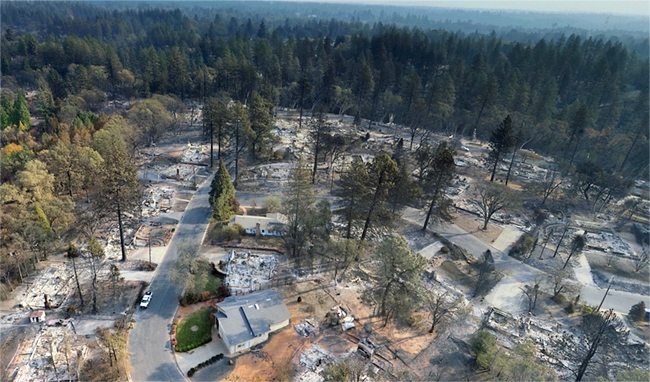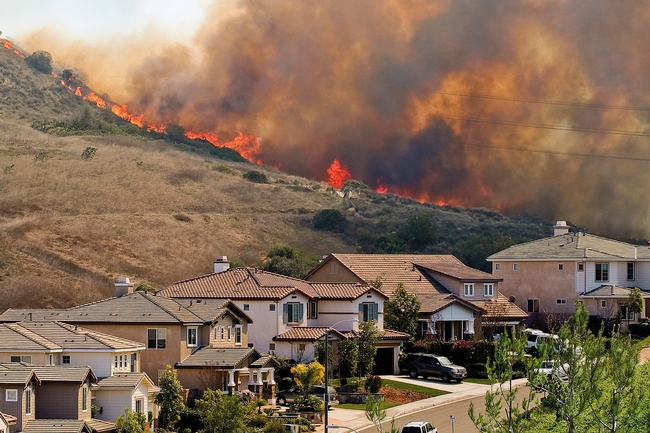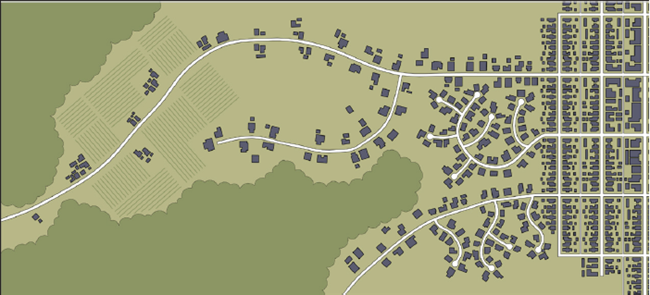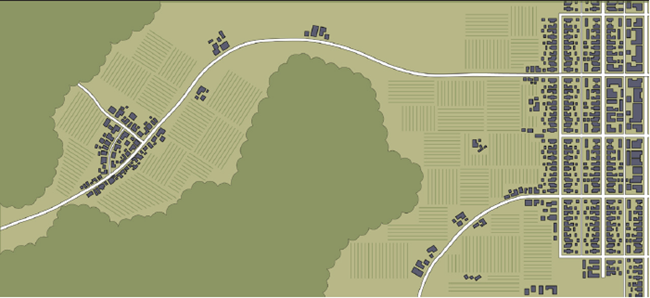Reducing wildfire risk includes building communities to coexist with fire
The Camp Fire that destroyed the town of Paradise and other wildfires that have devastated communities in recent years have convinced wildfire experts that Californians need to take more than one approach to coexist with fire.
To better protect new houses against wildfire, California has building codes, but where residential communities are built on the landscape and how they are designed are also very important to limit wildfire-related losses, according to University of California Cooperative Extension specialists Max Moritz and Van Butsic.
“Defensible space and vegetation management is important, but in the long term, where and how we build new developments will be equally important for keeping Californians safe,” said Butsic, who studies land use.
To develop their recommendations for reducing wildfire risk for future community development, Moritz, who specializes in wildfire, and Butsic reviewed fire studies and consulted firefighters and community planners.
Their new publication, “Building to Coexist with Fire: Risk Reduction Measures for New Development,” is designed for city planners, fire districts and communities to incorporate community-scale risk reduction measures when building or rebuilding in fire-prone areas.
“There is currently little codified guidance for where and how to build our communities in California, aside from building codes for individual structures and a few requirements for road access and water supplies,” said Moritz, who is based at UC Santa Barbara.
Wildfire consultant and architect David Shew, who retired as a CAL FIRE chief after 31 years, said, “I can state without hesitation that the land use planning principles and design recommendations identified in this study are necessary steps to help increase wildfire resiliency to existing and future communities. Being a first-hand witness to the increasingly destructive nature of wildfires, I can attest to the value and necessity for these improvements to be integrated into our built environment. This should become a much-used reference for every planning and fire official who face wildfire impacts.”
To reduce fire vulnerability of communities, Moritz and coauthor Butsic, who is based at UC Berkeley, recommend including fire professionals and biological resource experts early in the community planning process. They also recommend considering the placement of communities on the landscape, such as near bodies of water and agricultural land, and how they are laid out to minimize exposure to wildfire. Key considerations include defensibility, risk of ignition and ease of evacuating residents.
“This report provides both a robust justification for integrating resilience practices into land use planning and community design, and a toolbox for doing so,” Sarah G.Newkirk, director of disaster resilience with The Nature Conservancy in California. “The risk reduction measures described can be put to use immediately – ideally in combination with each other – both in ongoing wildfire recovery planning, and in local hazard mitigation planning. Furthermore, the report should be a wake-up call to FEMA to think broadly about how best to support wildfire mitigation in California.”
To more efficiently reduce fuel in new communities, Moritz and Butsic write, “The design, maintenance and use of defensible space for fire protection is easier when neighborhoods are developed more densely and are built to stringent fire-resistant building codes.”
In the 31-page publication, they present risk reduction measures for four design contexts:
- landscape setting – engage in strategic planning much earlier, use hazard maps and use major landscape features
- separation from wildfire source—use nonflammable amenities in design, employ safe setbacks on slopes and concentrate on inner side of roadways
- density management – cluster with other homes
- protective infrastructure – harden public facilities and refuges, locate power lines underground and augment water requirements.
They provide examples for each risk reduction measure, along with some discussion of challenges associated with each measure.
“Our hope is that this guidance will be helpful for agency personnel involved in evaluating and approving future development in California,” Moritz said. “Because there is a pressing need for additional housing in California, communities must be built with design principles that make them safer to inhabit and less vulnerable to inevitable wildfires.”
The publication “Building to Coexist with Fire: Risk Reduction Measures for New Development” can be downloaded for free at https://anrcatalog.ucanr.edu/Details.aspx?itemNo=8680.
Comments:
Good point: It's true that there are fewer options for existing communities. For those already living in fire-prone areas, reducing risk may be more about retrofitting.
That said, there are several RRMs which are not related to clustered development, and these other RRMs can provide some guidance for this type of retrofitting (e.g., augmenting water supplies, reducing potential power line ignitions). Identifying buffering lands (e.g., via irrigated green space) within and around communities, as well as designing refuges of last resort, are other RRMs that can be implemented for existing communities. Several of the RRMs will hopefully be useful as communities rebuild after fires, too.







Posted by Kit Veerkamp on May 5, 2020 at 7:47 AM